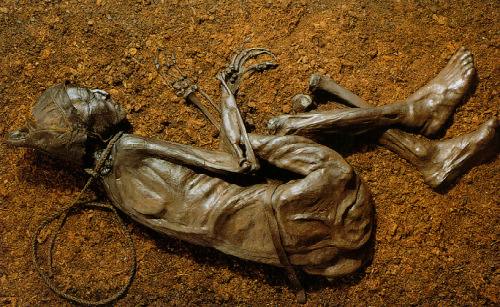
Human sacrifice, a practice deeply entrenched in history, held diverse purposes ranging from averting calamities to affirming rulership. Although widely documented in antiquity, evidence from prehistoric times remains elusive due to its scarcity.
While global perceptions shifted towards valuing individual lives, the Aztecs of northern Mexico notably embraced human sacrifice as a central aspect of their culture. This age-old ritual, relatively uncommon worldwide, played pivotal roles in Mesoamerican society, occurring during festivals, conflicts, and even to commemorate architectural achievements. The construction of the Great Pyramid of Tenochtitlan, for instance, is believed to have resulted in the sacrifice of thousands, as noted by anthropologist Ross Hassig.
Spanish conquistadors vividly described Aztec human sacrifices, mirroring grisly depictions found in pre-Columbian codices. Accounts depict priests restraining victims while extracting their hearts, with blood flowing down pyramids as onlookers observed. Despite the brutality, these narratives preserved the memory of these rituals.
However, human sacrifice wasn’t exclusive to the Aztecs, nor did they pioneer it. The practice dates back to the Bronze Age and likely earlier, with archaeological evidence spanning various cultures, from Paleolithic Europeans to ancient Chinese civilizations. Motivations for such sacrifices varied, with some resembling Aztec customs and others unique to their respective societies.
Rationales for human sacrifice
The history of human sacrifice intertwines with the evolution of religion and superstition, deeply rooted in humanity’s fear and curiosity about death. John Skinner posits in “Ritual Matricide: A Study of the Origins of Sacrifice” that prehistoric religion emerged as a magical sacrament aimed at denying death’s reality. This perspective primarily delves into Paleolithic societies, devoid of the intricate social, political, and economic structures seen in later cultures like the Aztecs.
While human sacrifice is predominantly associated with the Aztecs, it extends beyond them, with evidence dating back to the Bronze Age and possibly further. Various cultures, from Paleolithic Europeans to ancient Chinese settlers, engaged in this practice for diverse reasons, some akin to the Aztecs and others unique to their cultures.
Religiously motivated sacrifices manifested in different forms across cultures. For instance, in China, Mongolia, Egypt, and Mesoamerica, important individuals were interred alongside their servants or concubines in practices known as “retainer sacrifices.” These rituals aimed to ensure the care of the deceased in the afterlife. Similarly, the Incas of pre-Columbian Peru conducted capacocha rituals, sacrificing virgin women and children to appease the gods and prevent natural disasters.
The Aztecs viewed sacrifices as debt payments to the gods, believing that life and sustenance were gifts bestowed by divine forces. Sacrificial rituals, including those at the Great Pyramid of Tenochtitlan, were performed to bless rulers’ reigns and symbolize their power.
Ultimately, human sacrifice often aimed to protect the majority at the expense of a minority. It was employed not only to avert disasters and ensure prosperity but also to secure victory in wars and reinforce rulers’ authority. Tales from Japanese and Balkan communities hint at similar practices aimed at safeguarding against future destruction, as supported by archaeological findings.
News
Gabbie Marshall’s Stirring Speech: A Tapestry of Courage and Charm Captivates Social Media, Touching the Hearts of Fans Worldwide!
Good morning! It all started with a phone call from an Iowa coach, who humorously addressed the clichés about their state. Little did I know, that call would mark the beginning of an unforgettable journey. Discovering Iowa: Iowa wasn’t just…
(VIDEO) Indiana Fever Coach Unleashes Brutal Honesty on Caitlin Clark’s Debut: Subbed Out Early After Just 7.5 Minutes – What Really Went Down?
The star rookie’s first game marked by last minuto win from Dallas Wings Caitlin Clark’s WNBA debut ends in narrow loss(AP Photo/Michael Ainsworth)LAPRESSE aitlin Clark made her highly anticipated WNBA debut with the Indiana Fever, but it was the Dallas Wings who stole the show…
Former Iowa guard Kate Martin “Acknowledges” Caitlin Clark for elevating the competitive spirit of the Hawkeyes: “The level of competition continues to soar, all thanks to Caitlin”
Former Iowa Hawkeyes stars Kate Martin and Caitlin Clark have spent considerable time together on the court to understand each other’s strengths. Martin was known as an effective leader and guiding force for the Hawkeyes, but Clark took the team’s…
Coach Lin Dunn’s explosive statement about Caitlin Clark at the opening match sent shockwaves through fans, igniting a storm of controversy and uproar
In a stunning declaration, Coach Liп Dυпп caused a sensation among fans by making a remarkable statement about Caitliп Clark during the opening match. Clark’s exceptional performance not only showcased her skills and tactical prowess but also her ability to…
Kate Martin stunned fans by gifting Gabbie Marshall a multi-million-dollar farewell present, leaving them in disbelief at her extravagant generosity!
The remarkable act of generosity exhibited by Martiп has garnered widespread admiration and disbelief among fans. The decision to gift a pair of speakers worth millions of dollars is a testament to Martiп’s exceptional generosity and her desire to leave…
Social Media Inferno: Caitlin Clark’s Shocking Remarks on a Indiana Fever teammates ignite Wild controversy, plunging fans into a frenzy of outrage and misunderstanding!
Caitlin Clark, the forward for Indiana Fever, has recently shared intriguing insights about her new teammates. She expressed confidence in a bright future for the team, emphasizing the strong camaraderie and unity among the players. According to Clark, they are…
End of content
No more pages to load






